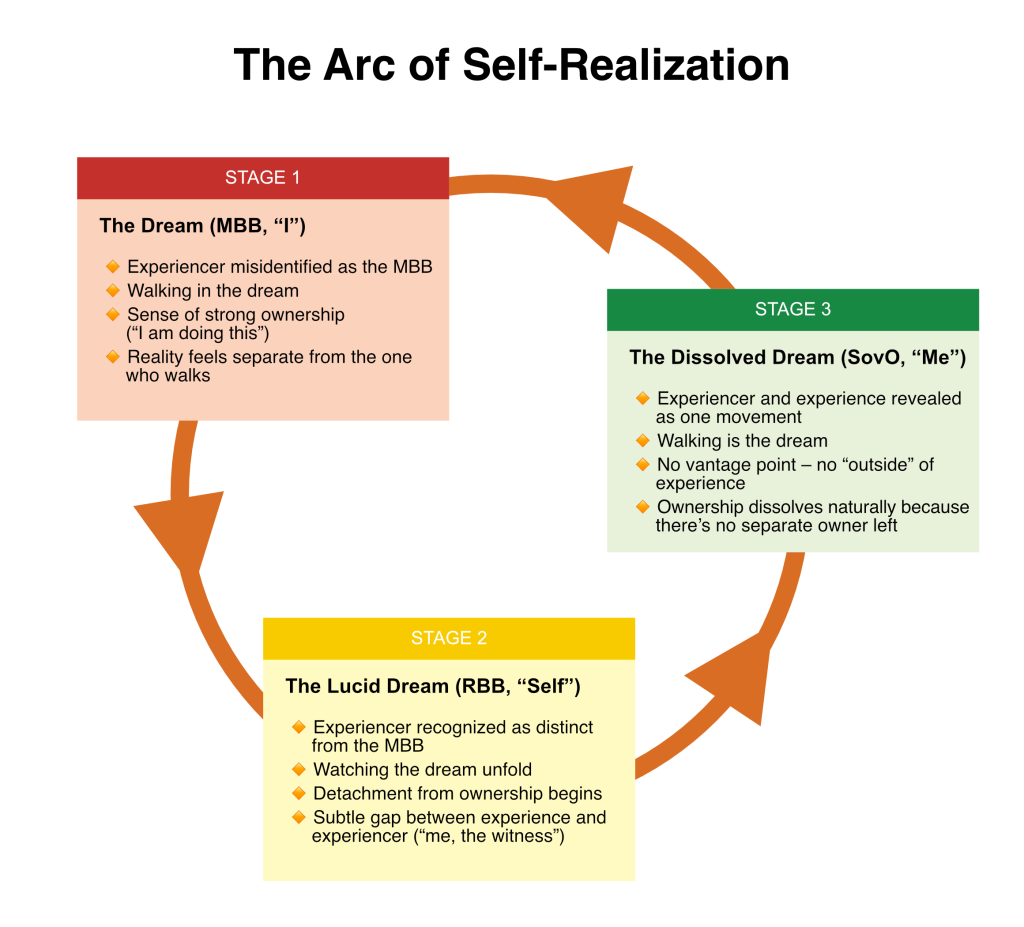The Arc of Self-Realization
This page is an invitation to notice where you might be walking along your own arc of self-realization. In MirrorWork, we have identified three clearly distinguished stages of self-realization, which all position the experiencer a little differently. Use this as a guiding map, not as a doctrine. Please refer also to the section explaining the layers of identity here.

These stages are not steps on a ladder but movements in a cycle. We weave in and out of them many times over a lifetime—sometimes even within the same day. The arc is alive, not linear.
Stage 1: The Dream (MBB, “I”)
Stage 1 is the usual default setting for anyone incarnating. We identify strongly—if not completely—with the personality shaped by our early experiences and socialization. This is the part we call the MBB (Memory-Based Being) in MirrorWork. Please understand that there is nothing wrong in identifying yourself with the MBB: this is the whole purpose of the game of being an incarnated human! However, there may come a point in your life when you start to question the default settings—and probably you already have because you’re reading this.
In stage one, you are the walker in the dream and think you are doing everything in your life, but have no control over what actually happens to you. You have a strong ownership of your actions. You think your incarnated part (MBB) is the experiencer, and you feel that the world around you is separate from you. You are both the subject of your dream and at the mercy of it. Life feels very personal and intense. This is the default setting for virtually all of us.
Stage 2: The Lucid Dream (RBB, “Self”)
When you have started to question the default setting, you may have insights and epiphanies that show you that your ideas about yourself and reality are actually unfounded. This is what is usually called ”spiritual awakening.” At its deepest, it changes your perceptions completely.
In stage two, you realize that you are “somebody” or “something” that witnesses your life, that watches the MBB go about its daily chores—its dream life. The experiencer is no longer the MBB but the one who “sees” the MBB. In MirrorWork, we call this witness the RBB (Resonance-Based Being). RBB is the unincarnated part of your Larger Self. You don’t claim a strong ownership of the MBB’s actions anymore because you realize they are happening in a dreamlike world. But there is still a gap between the witness and the witnessed dream, even if the sense of separation isn’t nearly as prominent as in Stage 1.
This is also the stage where we start to realize that our experiences are not random and that we are not at the mercy of any “forces” outside of ourselves. At this stage, we often get interested in trying to manipulate the dream in various ways (synchronicity experiments, manifestation techniques, etc.), and with varying success. The dream character (MBB) may become a subject of RBB’s experimentations, which can reveal a lot about how reality actually works.
But there’s yet another step to take, about which we rarely hear anything spoken.
Stage 3: The Dissolved Dream (SovO, “Me”)
Whereas in Stage 2, there is still the observer and the observed, in Stage 3, this separation dissolves completely. What is left is “that which happens” without any story attached to it. This stage is hard to express in words, as any words imply a “chooser,” someone choosing how to describe this stage, and this almost automatically collapses this stage back into stage 2.
However, this stage can be experienced even though it is impossible to separate the experiencer from the experience because they are the same and “move” together. The experience of experiencing is, nevertheless, something that never vanishes completely. That is what we refer to in our three-fold identity description as “Me” (with a capital M; not to be confused with the lowercase “ego-me”). What is left is only the experience itself, inseparable and without ownership. In Stage 2, you can detach from your dream character and witness it “outside” of itself. In Stage 3, that witness has merged back into the flow.
In Closing
This is just an outline of the different stages of self-realization. There are many variations of this. This outline is meant to help you assess where you might stand in your unique journey of unfolding, but it is not a rigid system. There are actually no stages or steps, but we fluctuate constantly in and out of all these three phases. What changes when your self-realization deepens is that you probably spend less and less time in Stage 1 and tend to naturally gravitate towards Stage 3, using Stage 2 as your “center stage.”
All stages are natural parts of the human journey, and you can’t rank people by using this schema. No one is “more” or ”less” advanced: we are all learning about these three stages in various ways. However, MirrorWork can help you learn to distinguish these stages in your life and thus give you a better sense of who you are and where you are.
Try this
Notice today which stage you feel you’re inhabiting — and see what happens when you soften your hold on it.
